アンティークミシン、ひとり鑑賞会してみた。(愛知県名古屋市千種区姫池通 骨董買取 古美術風光舎)
2025.08.08
おはようございます。
朝出勤したところ、テーブルの上にいきなりアンティークミシンが!。先日お持込されたお客様からの買取の御品でして、長年大切にしておりました御品をお譲りいただき誠にありがとうございました。
いきなりテンションがあがりまして早速勝手にひとり鑑賞会が始まりました。というのも実は洋裁歴30年、ミシンも数台使い分けながら縫ったりしていたりと少しはミシンのことをわかっているつもりなのですが、とはいえアンティークミシンはじっくり眺める機会はあまりありません。
という訳で、本日は私の拙いオタク知識と共にアンティークミシンを一緒に鑑賞してみたいと思いますのでご興味ございましたらお付き合いくださいませ。
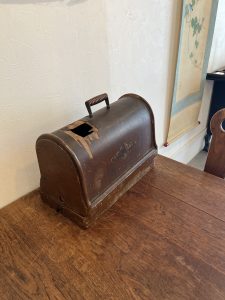
破損がみられますが、旅行用のアンティークの
スーツケースに見えますね笑。
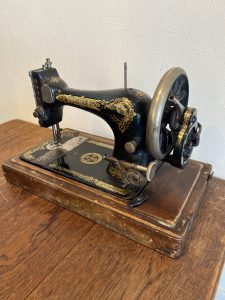
ジャーン、登場。
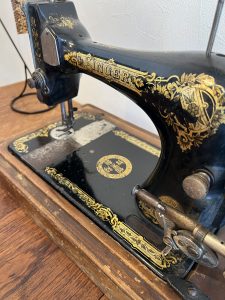
よくみると、用途がわからないパーツもあります
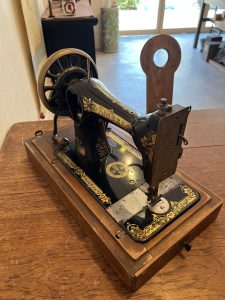
背面の装飾も手をぬいていませんね。
それにしてもアンティークのロゴはかわいい。
さてさて、お仲間スタッフ曰く「重すぎて持ちあがりません…」ということでしたので、持ち上げることは諦めまして、ここでケースを開けてみることに。ケースを開けると各稼動部にさしたであろう油のにおいがプーンとしてきます。如何せん古いミシンですので何度も何度も油をさして、そして酸化していったようなにおいであります。
そうなると、このミシンの出所と時代が気になるところ。まずは、こちらのミシンの自己紹介していきましょう。
シンガー製手回し式ミシン New Family Model(おそらく1910年製)
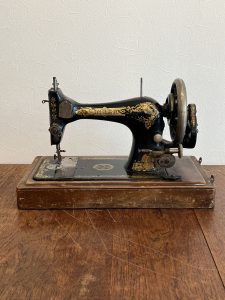
シンガーミシン、聞いたこともある方もおいででしょうが、1851年にアイザック・メリット・シンガーが第1号実用ミシンの特許取得、世界で最も古くからミシンを製造、170余年続く、そして広く知られているミシンブランドであります。手回しミシンから、足踏みミシン、電動ミシン、電子ミシン、コンピュータミシンへと 次々と機能の革新、現在も愛用者の多いミシンブランドでありますが、手動式をみたのは初めてです。
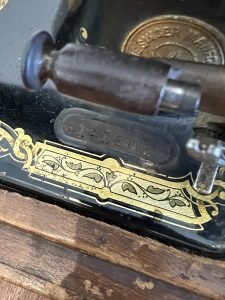
年式がかわるロゴとシリアルナンバーはここに。
ロゴマークとシリアルナンバーを追跡して調べたところ1910年にスコットランドからアメリカに工場を移した頃に作られたミシンのようです。油もさしておりましたので、使い込まれた印象ですが、ハンドルを動かしてみましたが、なんとか動きました。まずはボディの鑑賞からいきましょう。

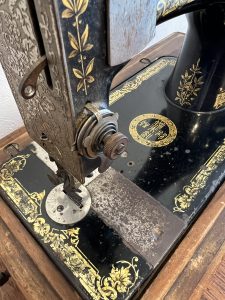
使い込まれて少々模様が剥がれていたり錆びたりしている部分もありますが、本体の独特の絵の模様はアカンサ柄と呼ばれる柄。ヨーロッパでは建築や装飾のモチーフとなっていたようです。プーリーや本体の鋳物の黒はジャパニングと言われ、日本の漆塗りが影響したとも言われています(かっこいい)。また、天板中央部に漢字のような文字が入っているので、日本輸出向けなのでしょうか。
オタク目線でいうと、ミシンを使う時ボディ中央の空洞の開口部のスペースは結構気になるところでして。内部がカーブでしっかり開いているのは縫いやすいだろうな…。そしてなによりもこのカーブは、デザイン的にもエレガントですよね。最近のミシンですとボディ上部にコンピューターの本体やディスプレイがぎっしり入っているため構造上スペースがとれないですが、このアカンサ柄のデザインを眺めながらのソーイングとは優雅な気分でしょうね。
また、先ほども述べましたが「重くて運べない」のは、縫う方としては安定しててある程度重さがあったほうがミシンは縫いやすいので、重すぎではありますがありっちゃありなのか。それにても現代のミシンと比べると当然ですが使われいる部品やパーツはここまで少なくてシンプルなのか。
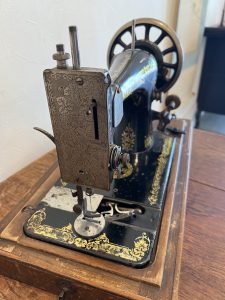
側面の部分も金属に彫りが入っていたり当時ミシンが高級品だったのかな、なんて伺えしれますね。
ここからは内部の話ですが、一番驚いたのは初めて見た下糸部分の長舟型シャトルというボビンケースというのがありまして(というか、ケースではなくボビンそのものをセットするタイプでした)。上手く取り出すことができなかったので、画像では少々分かりにくいですね。現在のミシンは丸いボビンをそのまま、あるいはボビンケースなるものに入れて設置するので、この珍しい長細いシャトル、どうやって糸巻くのだ?
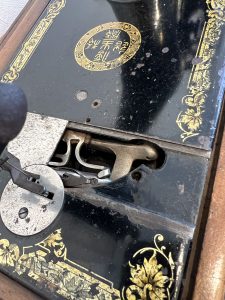
長舟型シャトルというボビンがこの中に横たわっています。
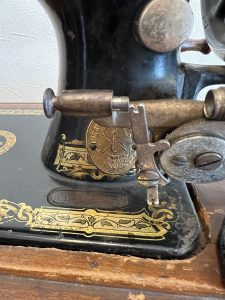
調べますと、エンブレム前部のよくわからいパーツが長舟型シャトルに下糸を巻くところだったようです。なお、使い方はわかりません。
で、オタクさく裂しまして下部も覗いてみました。長舟型シャトル下糸の動くボビンケースがシンの下側を左右に往復してハンドル1回転で3針縫える仕組みのようです。現代のミシンと比べますと内部はいたってシンプル。現在は、全回転と半回転があるのですが、こちらはもちろん半回転でありました。動かして下部から眺めてみましたが、スピンが左右に行ったり来たりしてました。

あ、すみません。とうわけで個人的にオタクがさく裂し、勝手にアンティークミシンの一人鑑賞会をしていたわけですが、こうなると手動式を使って縫ってみたい…。ですが当の使い方も分からずとりあえず眺めているだけなのですが、こうして眺めるだけでもなんだかワクワクするので、今日一日は、時折眺めて楽しもうではないか。
それではごきげんよう。(スタッフY)
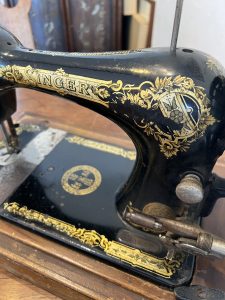
Good morning. When I arrived at work this morning, I found an antique sewing machine on the table! It was purchased from a customer who brought it in the other day, and we are very grateful that they entrusted us with this item that they had cherished for many years.
My excitement immediately skyrocketed, and I started appraising it on my own. You see, I have 30 years of experience in sewing, and I have used several sewing machines, so I think I know a little bit about them. However, I don’t often have the opportunity to take a close look at antique sewing machines.
So, today, I would like to share my humble otaku knowledge and take a look at this antique sewing machine together with you. If you are interested, please join me.
There are some damages, but it looks like an antique travel suitcase, doesn’t it? 😊
Here it is!
Upon closer inspection, there are some parts whose purpose is unclear.
The back decoration is also well-crafted. The antique logo is cute, isn’t it?
Well, according to my colleague, “It’s too heavy to lift…” so I gave up on lifting it and decided to open the case instead. When I opened the case, the smell of oil that had been applied to the moving parts wafted out. Since it’s an old sewing machine, it probably had oil applied to it many times over the years, and the smell is that of oxidation.
That makes me curious about the origin and era of this sewing machine. First, let me introduce this sewing machine.
Singer Hand-Crank Sewing Machine New Family Model (likely manufactured in 1910)
Singer sewing machines are probably familiar to some of you. Isaac Merritt Singer obtained the patent for the first practical sewing machine in 1851, making Singer the oldest sewing machine manufacturer in the world, with over 170 years of history, and a widely recognized sewing machine brand. From hand-crank sewing machines to foot-operated sewing machines, electric sewing machines, electronic sewing machines, and computerized sewing machines, Singer has continuously innovated its functions. It remains a popular sewing machine brand today, but this is the first time I’ve seen a manual model.
The logo and serial number, which change with the model year, are here.
After tracing the logo and serial number, it appears to be a sewing machine made around the time the factory was moved from Scotland to the United States in 1910. It had been oiled, so it looked well-used, but when I tried moving the handle, it still worked. Let’s start by examining the body.
While some parts are worn and have peeling or rust, the unique pattern on the main body is called the acanthus pattern. It seems to have been used as a motif in architecture and decoration in Europe. The black color of the pulleys and cast iron parts is called “Japaning,” and it is said to have been influenced by Japanese lacquerware (cool). Additionally, there are characters resembling Chinese characters on the central part of the top plate, so it might have been made for export to Japan.
From an otaku perspective, the space around the central opening of the body is quite noticeable when using the sewing machine. The curved interior opening seems to make sewing easier… And above all, this curve is elegantly designed. In modern sewing machines, the upper part of the body is packed with computer components and displays, leaving no structural space for such a design. However, sewing while admiring the acanthus pattern must be a truly elegant experience.
As I mentioned earlier, although it is heavy and difficult to move, from a sewing perspective, a sewing machine is easier to use if it is stable and has a certain amount of weight, so even though it is heavy, it may be acceptable. Compared to modern sewing machines, it is obvious that the number of parts and components used is much smaller and simpler.
The sides also have metal engravings, which makes me wonder if sewing machines were luxury items at the time.
Moving on to the internal components, what surprised me the most was the long, boat-shaped shuttle bobbin case in the lower thread section (or rather, it was a type where the bobbin itself was set directly into the case). I couldn’t remove it properly, so it’s a bit hard to see in the image, but modern sewing machines use round bobbins either directly or in a bobbin case. How does this unusual long shuttle wind the thread?
The long-boat-shaped shuttle bobbin is lying inside here.
Upon investigation, it seems that the unclear part at the front of the emblem was where the lower thread was wound onto the long-boat-shaped shuttle. However, I don’t know how it was used.
So, my inner otaku took over, and I peeked inside the lower part as well. It seems that the bobbin case holding the lower thread of the long boat-shaped shuttle moves back and forth under the needle, allowing three stitches per handle rotation. Compared to modern sewing machines, the internal mechanism is quite simple. Currently, there are full-rotation and half-rotation models, but this one, of course, was a half-rotation model. When I moved it and looked from below, the shuttle was moving back and forth.
Oh, sorry. So, I let my inner otaku run wild and ended up doing my own appraisal of the antique sewing machine, but now I want to try sewing with the manual one… However, I don’t know how to use it, so I’m just looking at it for now, but even just looking at it makes me excited, so I’ll enjoy looking at it from time to time today.
Take care. (Staff Y)
*******************
ご実家の整理やお片付けなどをされている方のご相談などが多くございます。
お片付けなどくれぐれもご無理のないようになさってくださいませ。
風光舎では古美術品や骨董品の他にも絵画や宝石、趣味のお品など様々なジャンルのものを買受しております。
お片付けをされていて、こういうものでもいいのかしらと迷われているものでも、どうぞお気軽にご相談下さいませ。
また風光舎は、出張買取も強化しております。ご近所はもちろん、愛知県内、岐阜県、三重県その他の県へも出張いたします。
まずは、お電話お待ちしております。
愛知県名古屋市千種区姫池通
骨董 買取【古美術 風光舎 名古屋店】
TEL052(734)8444
10:00-18:00 OPEN

